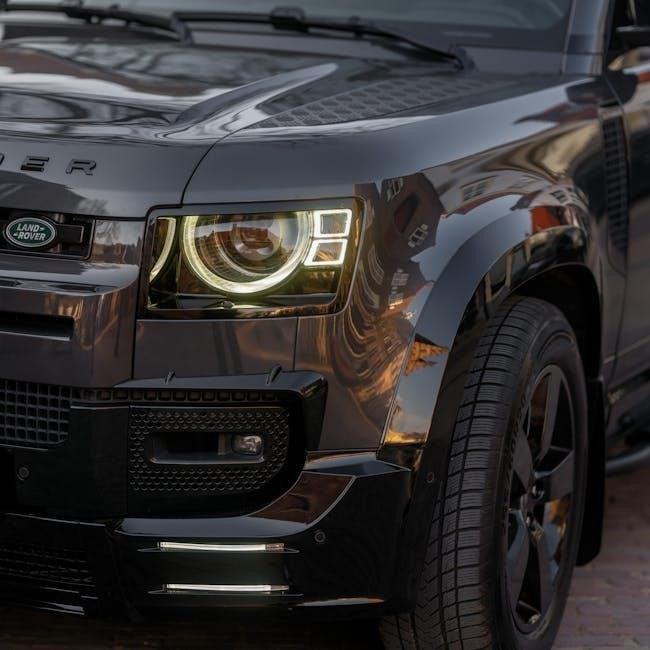Car headlight bulbs are essential for road safety, visibility, and driving confidence․ With various types like halogen, HID, and LED, they ensure proper illumination and clarity on the road․
1․1 Importance of Proper Headlight Functionality
Proper headlight functionality is crucial for road safety, ensuring drivers can see and be seen․ Poor visibility increases accident risks, especially at night or in low-light conditions․ Dim or faulty bulbs can blind others, leading to dangerous situations․ Modern bulbs like LEDs offer enhanced brightness and durability, reducing maintenance needs․ Always choose bulbs that meet your vehicle’s specifications to maintain optimal performance and safety․ Regular checks and timely replacements are essential to avoid potential hazards, ensure compliance with road safety standards, and maintain your vehicle’s overall appearance and functionality․
1․2 Overview of Headlight Bulb Types
Headlight bulbs come in various types, each offering distinct advantages․ Halogen bulbs are traditional and cost-effective, providing reliable light output․ HID (High-Intensity Discharge) bulbs produce brighter, whiter light but may require ballasts․ LED bulbs are energy-efficient, long-lasting, and emit minimal heat, making them a popular upgrade․ OLED bulbs offer advanced customization and superior light quality; Understanding these types helps drivers choose the best option for their needs, balancing brightness, durability, and budget․ Proper selection ensures optimal visibility, safety, and compliance with vehicle specifications․
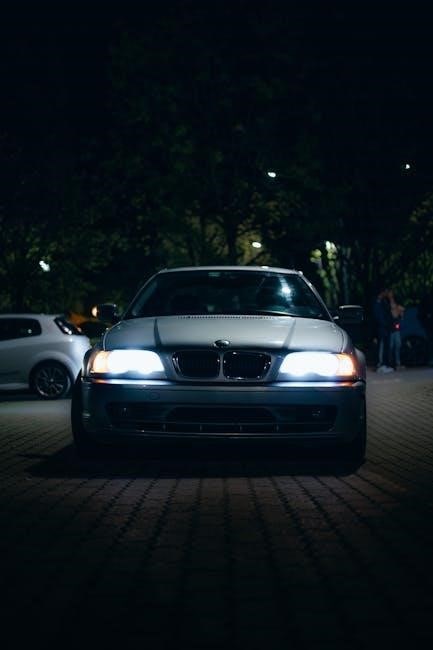
Types of Car Headlight Bulbs
Modern vehicles use halogen, HID, LED, or OLED bulbs․ Each type offers unique benefits, such as brightness, energy efficiency, and lifespan, catering to different driving needs․
2․1 Halogen Bulbs
Halogen bulbs are the most traditional and widely used headlight option․ They consist of a tungsten filament enclosed in a glass bulb filled with halogen gas, enhancing durability and brightness․ Known for their reliability and affordability, halogen bulbs are a popular choice for many drivers; They provide decent illumination and are easy to replace, making them a practical option for everyday use․ However, they are less energy-efficient compared to LED or HID bulbs and have a shorter lifespan․ Despite these drawbacks, halogen bulbs remain a trusted choice for their simplicity and effectiveness in standard lighting conditions․
2․2 HID (High-Intensity Discharge) Bulbs
HID (High-Intensity Discharge) bulbs produce light through an electric arc between two electrodes in a gas-filled chamber․ They are known for their intense brightness, delivering a crisp, white light that enhances visibility and reduces eye strain․ HID bulbs are more energy-efficient than halogen bulbs and have a longer lifespan․ However, they are more expensive and complex to install․ Their high color temperature (around 4000K-6000K) provides a modern, sleek appearance․ Despite these advantages, HID bulbs require a ballast to operate, which can add bulk and complexity․ They also take a few seconds to reach full brightness, making them less ideal for sudden lighting needs․
2․3 LED (Light Emitting Diode) Bulbs
LED (Light Emitting Diode) bulbs are a modern, efficient lighting solution for car headlights․ They emit light through semiconductor chips, producing a bright, white light with minimal heat․ LEDs are known for their long lifespan, energy efficiency, and instant-on capability, making them ideal for driving conditions․ They are also environmentally friendly, using less power than halogen or HID bulbs․ However, their initial cost is higher, and not all LED bulbs are compatible with every vehicle․ Proper installation and selection are crucial to ensure they function correctly and safely, without causing glare to other drivers on the road․
2․4 OLED (Organic Light Emitting Diode) Bulbs
OLED (Organic Light Emitting Diode) bulbs represent the latest advancement in automotive lighting․ Unlike LEDs, OLEDs use an organic material layer to emit light, offering superior flexibility and design potential․ They provide a wide viewing angle and even light distribution, enhancing visibility․ OLEDs are lightweight, energy-efficient, and can be designed into various shapes, making them ideal for modern vehicles․ However, they are currently more expensive and less common than LEDs․ Despite this, their unique features and benefits make them a promising option for future car lighting systems, combining performance with innovative design capabilities․

Factors to Consider When Choosing Headlight Bulbs
When selecting headlight bulbs, consider brightness, color temperature, compatibility with your vehicle, energy efficiency, and lifespan to ensure optimal performance and safety on the road․
3․1 Brightness and Lumen Output
Brightness, measured in lumens, is crucial for visibility and safety․ Higher lumen output ensures better illumination, reducing eye strain and enhancing nighttime driving safety․ LED and HID bulbs typically offer higher lumens than halogen bulbs, providing brighter light for clearer road visibility․ However, excessively high lumens can blind oncoming drivers, so it’s important to choose bulbs that meet legal standards․ Always check the manufacturer’s specifications to ensure the bulb’s lumen output is appropriate for your vehicle and driving conditions․ Proper brightness levels help maintain safety and visibility without causing discomfort to others on the road․
3․2 Color Temperature and Visibility
Color temperature, measured in Kelvin (K), affects visibility and comfort․ Lower temperatures (e․g․, 3200K) produce warmer, yellowish light, while higher temperatures (e․g․, 4000K–6500K) emit cooler, whiter tones․ Cooler tones enhance visibility by mimicking daylight, reducing eye strain and improving clarity․ However, excessively high temperatures can cause glare for oncoming drivers․ LED and HID bulbs often offer higher color temperatures, boosting visibility without increasing lumen output․ Balancing color temperature is key to ensuring safety and comfort for both the driver and other road users․ Always choose bulbs that align with your vehicle’s specifications for optimal performance․
3․3 Compatibility with Vehicle Make and Model
Ensuring headlight bulbs are compatible with your vehicle’s make and model is crucial for proper fitment and performance․ Each car has specific bulb requirements, determined by its electrical system and headlight housing design․ Always refer to your owner’s manual or use online bulb selection tools to identify the correct type and wattage․ Compatibility guarantees optimal light output, safety, and avoids potential electrical issues․ Some vehicles may require additional components like CANbus controllers or resistors for certain bulb types․ Double-checking compatibility ensures a seamless installation and proper functionality, preventing future troubleshooting or safety hazards․
3․4 Energy Efficiency and Lifespan
Energy efficiency and lifespan are critical factors when selecting car headlight bulbs․ LED bulbs are the most energy-efficient, consuming less power while providing brighter light․ They also last significantly longer than halogen or HID bulbs, reducing replacement frequency․ Halogen bulbs, though widely used, have shorter lifespans and higher energy consumption․ HID bulbs offer excellent brightness but may produce more heat and have a shorter lifespan than LEDs․ Choosing energy-efficient bulbs not only lowers long-term costs but also reduces environmental impact․ Always consider the balance between brightness, efficiency, and durability to make an informed decision for your vehicle’s lighting needs․
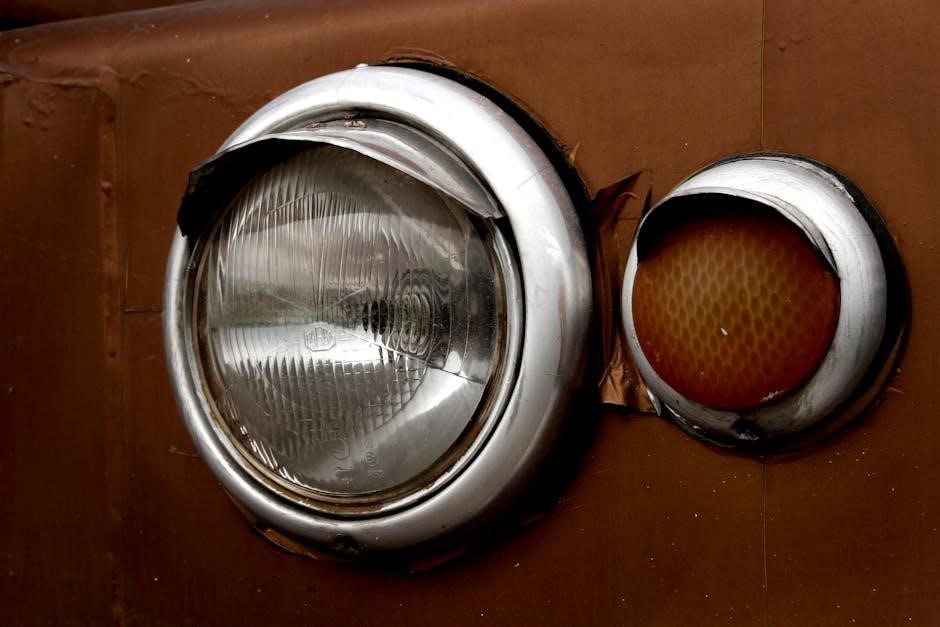
How to Determine the Correct Bulb Type for Your Vehicle
Consult your car’s owner’s manual to find specific bulb type recommendations․ Use online tools or databases to match your car’s make and model with the correct bulb․ Ensure compatibility and safety by checking for CANbus requirements if applicable․ Consider brightness, energy efficiency, and lifespan when selecting bulbs․ Verify reviews and installation guides for reliable and high-quality options․ Proper research ensures optimal performance and safety for your vehicle’s lighting system․
4․1 Using the Owner’s Manual
Your car’s owner’s manual provides essential information about the correct headlight bulb type for your vehicle․ It specifies the required wattage, voltage, and bulb size․ Look for the lighting or maintenance section, where you’ll find details on compatible bulb types, such as halogen, HID, or LED․ This ensures safety, performance, and compliance with your vehicle’s electrical system․ Always double-check the manual before purchasing or installing new bulbs to avoid compatibility issues․ If unsure, cross-reference the information with online databases or consult an auto parts store specialist for accurate guidance․
4․2 Online Tools for Bulb Selection
Online tools simplify selecting the right headlight bulbs for your vehicle․ Websites like OSRAM’s Lamp Replacement Guide or bulb finders on auto parts sites allow you to enter your car’s make, model, and year to find compatible bulbs․ Some platforms, such as Headlight Revolution, test LEDs in specific housings to ensure fitment and performance․ You can also search by bulb type or wattage to narrow down options․ These tools provide accurate recommendations, reducing guesswork․ For added convenience, some sites allow you to enter your vehicle’s registration number for precise matches․ Using these resources ensures you purchase the correct bulbs for safe and optimal performance․
The Installation Process
Replacing headlight bulbs involves accessing the bulb, removing the old one, and installing the new bulb securely․ Always consult your vehicle’s manual for specific instructions and safety tips․
5․1 Step-by-Step Guide to Replacing Headlight Bulbs
Replacing headlight bulbs involves several key steps․ First, consult your vehicle’s manual to identify the correct bulb type and location․ Gather necessary tools, such as screwdrivers, Torx bits, gloves, and safety glasses․ Open the hood and access the headlight assembly by removing screws or clips․ Disconnect the electrical connector carefully․ Release the retaining ring or clip holding the bulb․ Remove the old bulb and insert the new one, ensuring proper alignment․ Avoid touching the glass part with bare hands․ Reassemble everything, secure all parts, and test the headlights․ Dispose of the old bulb responsibly․ Always follow safety guidelines and specific instructions for your vehicle model․
5․2 Common Mistakes to Avoid During Installation
When replacing headlight bulbs, avoid common mistakes to ensure proper functionality and safety․ Not using the correct bulb type for your vehicle can lead to poor performance or legal issues․ Handle bulbs by the base, not the glass, to prevent oil residue and potential dimming․ Avoid over-tightening or stripping screws, which can damage the housing․ Never touch electrical connectors or components without proper insulation to prevent damage or injury․ Ensure all clips and screws are securely fastened to avoid loose parts․ Finally, always test the headlights after installation to confirm they are working correctly․ These precautions ensure a safe and effective replacement process․

Maintenance and Troubleshooting
Regular maintenance ensures optimal headlight performance; Clean lenses, check connections, and diagnose flickering bulbs promptly to maintain visibility and safety on the road․
6․1 Cleaning and Aligning Headlights
Cleaning and aligning headlights are crucial for maintaining visibility and safety․ Regularly wash the lenses with a soft cloth and mild soap to remove dirt and debris․ Avoid using harsh chemicals or abrasive materials that might scratch the surface․ For hazy or yellowed lenses, consider using a headlight restoration kit․ Proper alignment ensures the light beam doesn’t blind other drivers and illuminates the road effectively․ If misalignment occurs, adjust the headlights according to your vehicle’s manual or consult a professional․ Misaligned headlights can reduce night vision and pose a risk to road safety․
6․2 Diagnosing Flickering or Dim Bulbs
Flickering or dim headlight bulbs can indicate issues such as loose connections, worn-out bulbs, or electrical problems․ Start by checking the bulb socket for tightness and cleanliness․ Corrosion or dirt may cause poor contact․ If the bulb is old, consider replacing it with a compatible type․ Electrical issues, like faulty wiring or a failing ballast in HID systems, may require professional attention․ Always consult your vehicle’s manual for guidance․ If the problem persists after replacing the bulb, it may signal a deeper electrical fault․ Addressing these issues promptly ensures safety and optimal headlight performance․

Benefits of Upgrading to LED or HID Bulbs
Upgrading to LED or HID bulbs enhances brightness, energy efficiency, and lifespan․ They provide clearer vision, reduce eye strain, and lower long-term maintenance costs significantly․

7․1 Enhanced Visibility and Safety
Upgrading to LED or HID bulbs significantly improves visibility and safety on the road․ These bulbs emit a brighter, whiter light that illuminates the road more effectively, reducing eye strain․ The enhanced light output allows drivers to see potential hazards earlier, improving reaction time․ Additionally, the crisp, clear light reduces glare, making it easier for other drivers to see your vehicle․ This reduces the risk of accidents, especially at night or in low-light conditions․ The superior light quality ensures better clarity, making nighttime driving safer and more confident․ Enhanced visibility also helps other drivers see your vehicle more clearly, further improving overall road safety․
7․2 Cost Savings Over Time
Upgrading to LED or HID bulbs offers long-term cost savings despite their higher initial price․ LEDs and HIDs have significantly longer lifespans compared to traditional halogen bulbs, reducing replacement frequency․ LEDs, for instance, can last up to 50,000 hours, while halogens may need replacing every 1,000 to 2,000 hours․ This durability minimizes maintenance costs and the hassle of frequent replacements․ Additionally, energy-efficient LED bulbs consume less power, lowering fuel costs over time․ Their cooler operation also reduces wear on headlight housings, preventing premature aging and potential damage․ The combination of longevity and efficiency makes LED and HID bulbs a cost-effective choice for drivers seeking reliable, long-lasting lighting solutions․
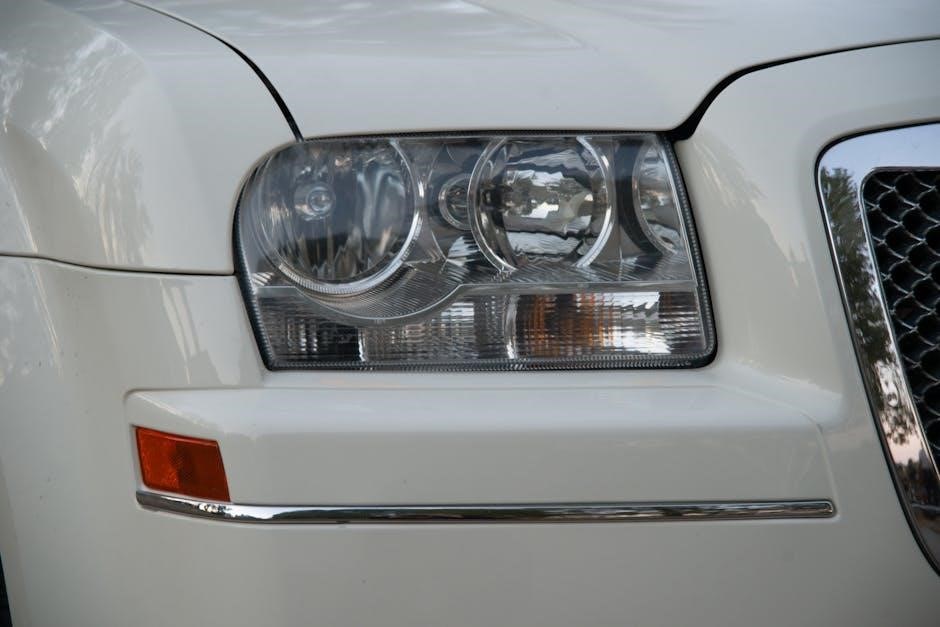
Safety and Legal Considerations
Proper headlight functionality is crucial for road safety and must comply with legal standards to ensure visibility and avoid accidents or fines․ Regulations vary by region․
8․1 Road Safety Standards for Headlights
Headlights must meet strict road safety standards to ensure optimal visibility and minimize glare for oncoming drivers․ Proper bulb type, brightness, and color temperature are critical to maintain safety․ Standards regulate light output, beam pattern, and bulb positioning to prevent accidents․ Compliance with these standards ensures uniformity across vehicles, enhancing overall road safety․ Regular inspections and upgrades are essential to maintain compliance and safety performance, reducing the risk of collisions and ensuring clear visibility for all road users at night or in low-light conditions․
8․2 Legal Requirements by Region
Legal requirements for headlight bulbs vary by region, with specific regulations governing bulb types, wattage, and compliance․ In Europe, ECE standards dictate allowable bulb specifications, while in North America, FMVSS regulations apply․ Asia follows similar regional standards․ These laws ensure bulbs meet safety and visibility criteria․ Compliance is mandatory to avoid penalties and ensure roadworthiness․ Always verify local regulations before upgrading or replacing bulbs․ Proper documentation and certification are often required․ Adhering to these standards ensures legal compliance and enhances safety for all road users, regardless of location or vehicle type․ Regional variations must be considered to avoid legal issues and maintain safe driving conditions․
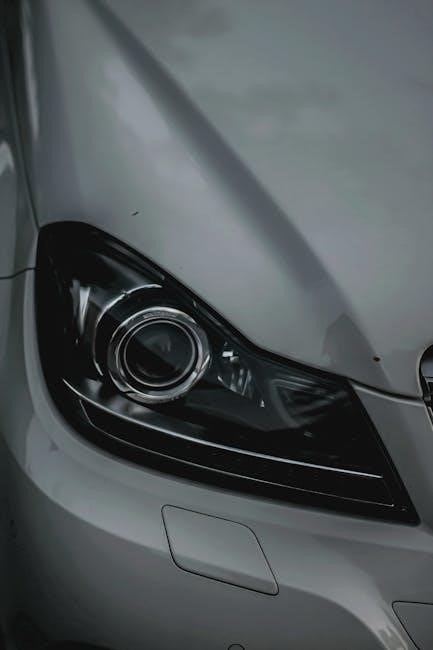
Environmental Impact
Energy-efficient LED bulbs reduce power consumption, lowering carbon emissions․ Eco-friendly designs minimize environmental impact, while proper disposal of old bulbs ensures responsible waste management and sustainability․
9․1 Energy Efficiency and Eco-Friendliness
Modern car headlight bulbs, such as LED and HID types, offer significant energy efficiency compared to traditional halogen bulbs․ LEDs, for instance, consume up to 80% less power while producing brighter light․ This reduction in energy consumption lowers carbon emissions, making them an eco-friendly choice․ Additionally, LED bulbs have a longer lifespan, reducing the need for frequent replacements and minimizing waste․ Their durability also decreases the environmental impact of manufacturing and disposal․ Eco-conscious drivers can opt for energy-efficient bulbs to contribute to sustainability while maintaining optimal lighting performance for safer driving conditions․
9․2 Disposal Considerations for Old Bulbs
Proper disposal of old headlight bulbs is crucial for environmental protection․ Halogen and HID bulbs should be handled carefully to avoid breaking, as they contain materials like mercury, which can be harmful if released․ LED bulbs, while more eco-friendly, may still require special recycling due to their components․ Check local waste management guidelines for designated facilities that accept automotive lighting waste․ Many auto parts stores and recycling centers offer drop-off services for used bulbs․ Ensuring responsible disposal helps minimize environmental impact and promotes sustainability․ Always follow regional regulations to safely discard old headlight bulbs and contribute to a greener planet․
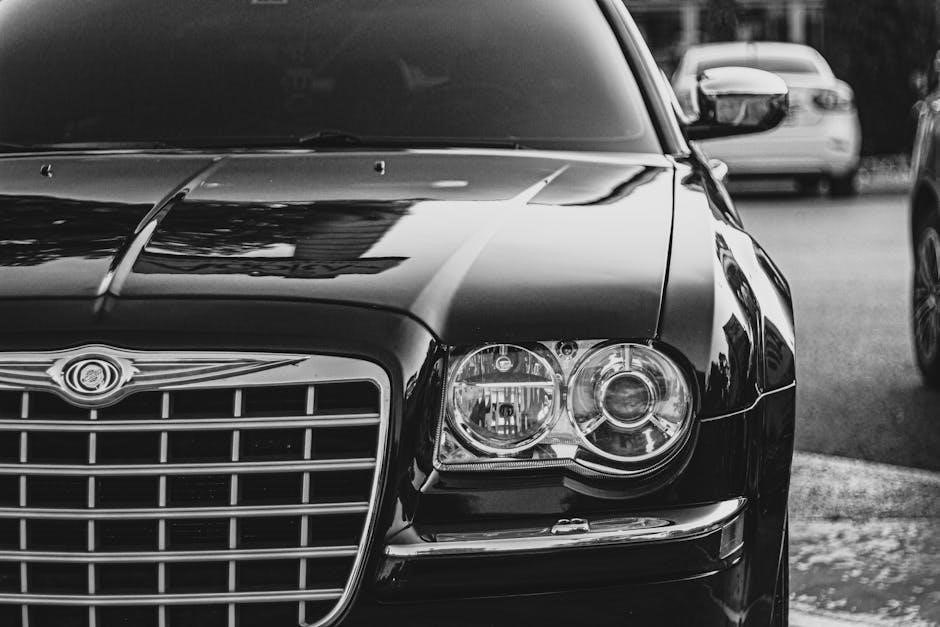
Future Trends in Headlight Technology
Advancements in LED and laser technology promise brighter, more energy-efficient headlights․ Smart lighting systems adapt to driving conditions, enhancing safety and visibility for future vehicles․
10․1 Advances in LED and Laser Technology
Recent advancements in LED and laser technology have revolutionized car headlight systems․ LEDs now offer higher lumens per watt, longer lifespan, and improved color consistency․ Laser technology, while still emerging, promises even greater efficiency and brightness․ Both technologies enable smaller, more compact designs, reducing heat output and increasing durability․ LEDs are becoming the standard for their energy efficiency and reliability, while laser-based headlights are being tested for their potential to illuminate farther with less power consumption․ These innovations are paving the way for smarter, more adaptive lighting systems that enhance safety and driver experience․
10․2 Smart Lighting Systems in Modern Vehicles
Smart lighting systems in modern vehicles integrate advanced technologies like adaptive beams and automatic dimming to enhance visibility and safety․ These systems use sensors and cameras to detect oncoming traffic, adjusting light intensity and direction dynamically․ Features like automatic high-beam control and glare prevention improve driving comfort․ Some systems even adapt to weather conditions or road types․ Energy-efficient LEDs and lasers enable these innovations, ensuring optimal performance while reducing power consumption․ These intelligent systems not only improve safety but also provide a more tailored and responsive lighting experience, making nighttime driving safer and less stressful for drivers․ They are a key part of modern automotive advancements․
11․1 Summary of Key Points
Proper headlight functionality is crucial for safety and visibility․ Halogen, HID, and LED bulbs offer distinct benefits, with LEDs being the most energy-efficient and long-lasting․ Always ensure compatibility with your vehicle’s make and model․ Brightness, color temperature, and energy efficiency are key factors when selecting bulbs․ Upgrading to LED or HID enhances visibility and reduces long-term costs․ Regular maintenance, such as cleaning and aligning headlights, is essential for optimal performance․ Adhere to road safety standards and legal requirements for headlights in your region․ Consider eco-friendly options and proper disposal of old bulbs․ Stay informed about advancing technologies like laser lights and smart systems for future upgrades․
11․2 Final Tips for Optimal Headlight Performance
Regularly inspect and clean headlight lenses to maintain clarity․ Ensure bulbs are properly aligned to avoid blinding others and reduce glare․ Replace dim or flickering bulbs promptly to maintain visibility․ Always follow the manufacturer’s guidelines for installation and upgrading․ Consider energy-efficient options like LED or HID for better performance and longevity․ Avoid using bulbs with higher wattage than recommended, as they may damage your vehicle’s electrical system․ For complex installations, consult a professional to ensure safety and compliance with legal standards․ Proper maintenance and smart upgrades will enhance your driving experience and safety on the road․
